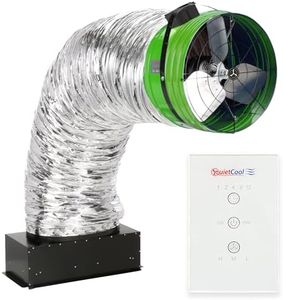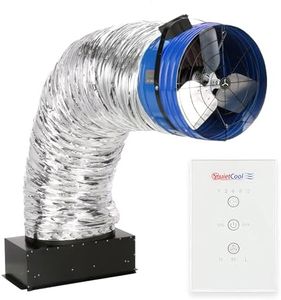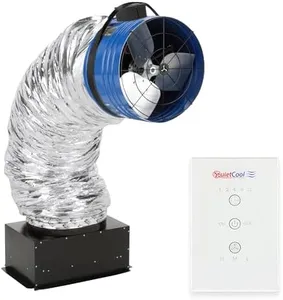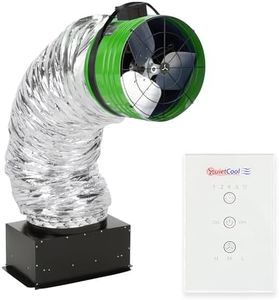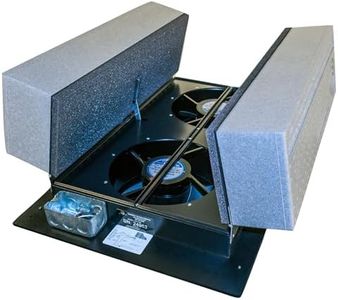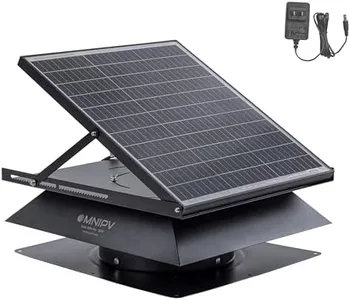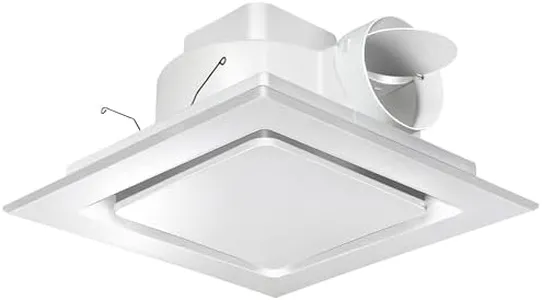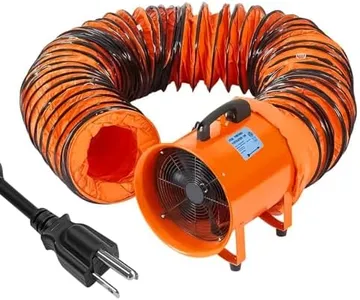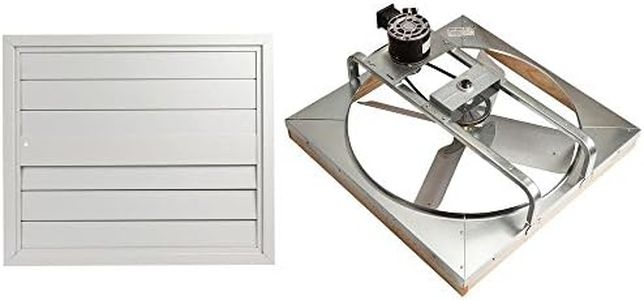10 Best Whole House Fans 2026 in the United States
Our technology thoroughly searches through the online shopping world, reviewing hundreds of sites. We then process and analyze this information, updating in real-time to bring you the latest top-rated products. This way, you always get the best and most current options available.

Our Top Picks
Winner
QuietCool QC ES-5400 RF Energy Saver Advanced Whole House Fan with Wireless Control - Up to 5003 CFM - As Low as 89 watts - Two Speed - Covers up to 2,502 SQFT - 10 Year Warranty
Most important from
124 reviews
The QuietCool QC ES-5400 RF is a powerful whole-house fan capable of moving up to 5,003 cubic feet of air per minute, which is excellent for cooling homes up to about 2,500 square feet. This high airflow means it can quickly bring fresh air inside, making it a good choice for larger spaces or hotter climates. It comes with two speeds and wireless control, so you can easily adjust settings without having to get up, adding convenience.
The fan is designed to be energy efficient, running at as low as 89 watts on its lower setting, which helps save on electricity compared to traditional fans or air conditioning. However, the product specs list a wattage of 497 watts, which likely represents the higher speed setting—still reasonable for the power it offers but worth noting for energy-conscious users. The unit is quite large (40 x 24 x 40 inches) and heavy (75 pounds), so installation will likely require professional help and adequate attic space for ventilation.
The 10-year warranty is a strong point, giving buyers confidence in its durability. This fan is well suited for homeowners looking to efficiently cool a larger home with easy controls and solid airflow, though installation and space requirements should be carefully considered.
Most important from
124 reviews
Quietcool QC CL-7000 RF Classic Advanced Whole House Fan with Wireless Control - Up to 6924 CFM - Two Speed - Covers up to 3,462 SQFT - 10 Year Warranty - Removable Grille
Most important from
87 reviews
The Quietcool QC CL-7000 RF is a powerful whole house fan designed to cool large homes up to about 3,470 square feet. It offers strong airflow with up to 6,924 CFM on high speed and 5,518 CFM on low, which means it can quickly move a lot of air to help reduce indoor temperatures effectively. It runs on a motor that uses between 794 and 1,147 watts depending on speed, reflecting decent energy efficiency compared to traditional air conditioning. The fan includes a wireless remote control with a timer, making it convenient to operate without needing to get up.
Installation is fairly straightforward, usually taking 1 to 2 hours, and doesn’t require major changes to your ceiling structure, which is helpful if you want a less invasive setup. The unit also has a damper system that helps keep out cold air when the fan isn’t running, improving year-round comfort. However, it does require at least 9.24 square feet of attic vent space to work properly, so it might need additional venting if your attic isn’t already well-ventilated. Weighing over 90 pounds, this fan is quite heavy, so installation might need two people or professional help.
This fan is ideal for homeowners seeking a strong, energy-efficient solution to cool a large house with easy-to-use controls and moderate installation effort. It is important to ensure your attic venting meets its requirements and to consider your expectations regarding noise.
Most important from
87 reviews
Quietcool QC CL-4700 RF Classic Advanced Whole House Fan with Wireless Control - Up to 4415 CFM - Two Speed - Covers up to 2,208 SQFT - 10 Year Warranty - Removable Grille
Most important from
206 reviews
The QuietCool QC CL-4700 RF is a strong choice for homeowners looking to cool and ventilate a medium-sized home (up to about 2200 sq. ft.) efficiently. It delivers a high airflow of up to 4415 CFM on high speed, which means it can cool your home quickly by circulating a lot of air. On the lower speed, it still moves a good volume of air (3402 CFM), providing flexibility depending on your cooling needs. Noise is kept reasonably low at 37.2 decibels, so it won’t be too disruptive when running. In terms of energy use, it employs a 551-watt motor on high speed, which is fairly efficient for the power it produces, with an energy efficiency rating of 8.02 CFM per watt.
Installation is designed to be straightforward and quick, usually taking 1 to 2 hours without the need for major structural changes, making it accessible for many homeowners. The built-in wireless RF control with a glass switch and a 12-hour timer adds modern convenience, letting you operate the fan easily without climbing into the attic. The fan also includes important features like insulated damper doors to prevent heat loss when the fan is off, and window locks for safety. However, to perform properly, it requires about 5.89 square feet of attic venting, which means you need sufficient attic vents or you’ll need to add them. It is powered by standard electrical power, not battery-powered.
Most important from
206 reviews
Buying Guide for the Best Whole House Fans
Whole-house fans are a great way to cool your home by drawing in fresh air from outside and expelling hot air from inside. They can be an energy-efficient alternative to air conditioning, especially in climates with cool evenings and nights. When choosing a whole-house fan, it's important to consider several key specifications to ensure you select the best fit for your home and needs.FAQ
Most Popular Categories Right Now
